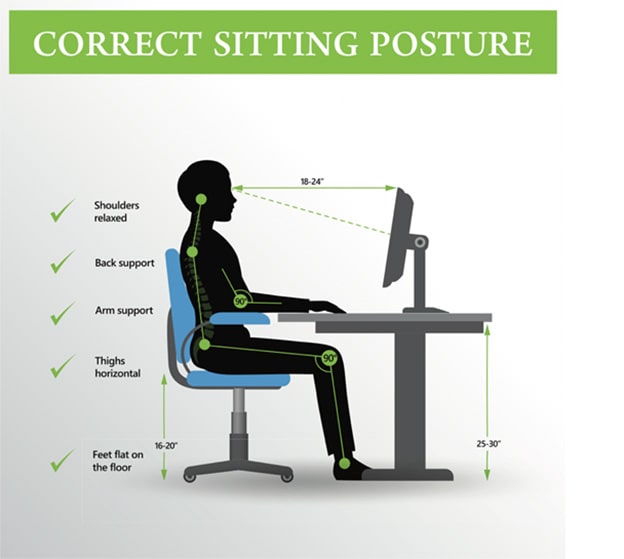If you have sciatica pain, you should avoid sitting for long periods. Instead, it would be best if you tried to stand or lie down, which puts less pressure on your spine and discs. Standing or lying down also prevents you from constantly irritating your sciatic nerve. You can also consider using back support to support the natural curve of your lower back and relieve pressure on your discs, nerve, and piriformis muscle.
How do I stop sciatica pain when sitting?
When sitting, sciatica sufferers should try stretching their lower back and hamstrings. These stretches help create space in the spine and relieve pressure on the sciatic nerve. The first stretch is the most effective. While sitting, place your left foot on the floor outside your right knee and your left elbow on the outside of your left knee. Maintain this position for 30 seconds.
Another effective remedy is to use a lumbar support pillow. This pillow will help support your lower back and reduce pressure on the sciatic nerve. You can also try to sit on a chair with built-in lumbar support. It is important to keep in mind that sitting for long hours can make your sciatic pain worse. It can also tighten the muscles that support the pelvis and lower back alignment. Therefore, it is important to take frequent breaks while you are sitting.
What does sciatica feel like when sitting?
If you’ve been diagnosed with sciatica, one of your most important actions is to avoid prolonged sitting. This is because sitting puts a lot of pressure on the lower back and glutes. Moving your body frequently can rest the sciatic nerve and allow it to stretch. Alternatively, you can try using a standing desk to relieve the pain. You can try sitting cross-legged if you want to use something other than a standing desk. This will stretch your back and legs and increase the area’s circulation.
People with sciatica must be extra careful about sitting and lifting. Sitting and standing for too long can cause pain in the lower back and feet. They should also avoid wearing high heels, tight pants, or carrying heavy objects in their back pocket. Fortunately, it’s fairly easy to prevent sciatica from developing. You can avoid the painful symptoms by avoiding sitting for long periods and wearing shoes that support the lower back.
What is the best sitting position when you have sciatica?
Sitting in a proper position is essential if you want to prevent your sciatica pain from getting worse. Sitting with good posture means keeping your weight evenly distributed. You can use a chair to help you balance yourself. You can also do stretches that target your lower back and piriformis muscles.
Many people suffer from sciatica pain when they are sitting. One of the worst sitting positions is cross-legged, which puts pain in the sciatic nerve. It also makes driving more painful, as the body is forced to flex the lower back to avoid discomfort.
Sciatica pain is a symptom of compression or inflammation of the sciatic nerve located under the spine. The condition can cause pain in the lower back, calves, and upper thighs. The best sitting position for sciatica sufferers reduces pressure under the thighs while maintaining a neutral spinal position. If you have sciatica, sitting with your back straight and in a chair with a backrest is important. You should also use a footrest if possible, as this keeps the legs at rest.
Does drinking water help sciatica?
Drinking water can help reduce the pain associated with sciatica. It has been found to improve the condition by flushing out toxins, improving digestion, and decreasing inflammation. It can also support the immune system and promote faster recovery from injuries. The recommended amount of water to drink is eight to ten glasses daily, depending on your weight and activity level.
Water helps keep the discs in the spine hydrated. If the discs are not well hydrated, they begin to shrink, placing pressure on the outer ring of the disc. This outer ring of the disc isn’t built for weight bearing, so if it becomes too dehydrated, it can collapse under pressure, placing extra pressure on the nerves.
Conclusion
Sciatica is a chronic condition with various causes, most commonly bone spurs, herniated discs, and pinched nerves. Prolonged sitting worsens sciatica because a good portion of your body weight is now being exerted on your sciatic nerves. Along with prolonged sitting, other factors like poor posture and weak core muscles can exacerbate your sciatica symptoms. Many also find it helpful to place a pillow between their knees to help relieve sciatica pain while sleeping on their side.
Many causes of back pain can radiate pain down the leg, such as a herniated disc. If their pain is very mild, then a lot of times, I might use some medication as well as some physical therapy. But sitting all that time isn’t necessarily the best thing for our bodies, and prolonged sitting can increase your risk of back pain and nerve problems like sciatica. This increased compression in and on our spinal discs and spinal column increases the pressure against our nerve roots that make up our sciatic nerve.

Doctor Osvaldo Pepa, Neurosurgery Service Physician at Hospital San Martin, La Plata, Argentina. I graduated last November 16, 1984 with a Medical Degree at the Universidad Nacional de La Plata. The Medical Board of La Plata, District 1, licensed me as a Neurosurgeon in 1990. I hold a Provincial and National License and an active member of the Neurosurgery Society of La Plata, World Ozone Therapy Federation, and Inter American Society of Minimally Invasive Surgery.
